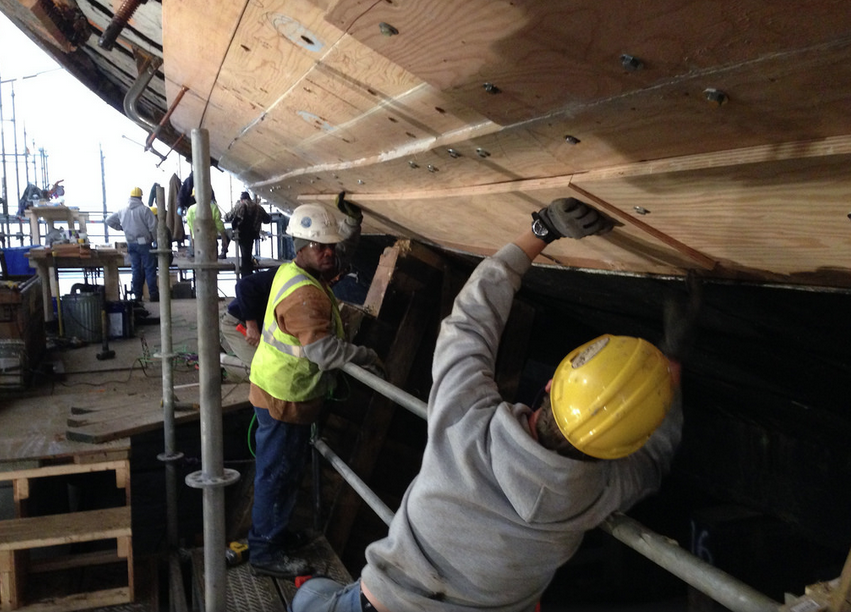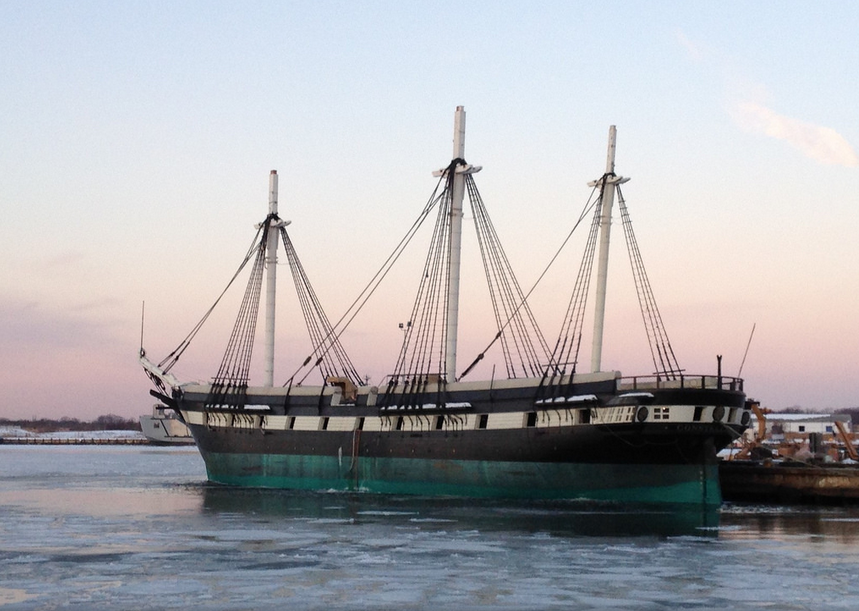
As Melvin Moses and William Jackson shoveled failing snow off the deck last week, water filled up around Baltimore’s historic, tall ship Constellation as it prepared to leave its Curtis Bay dry dock.
The USS Constellation, a U.S. Navy “sloop-of-war,” dates to 1854. The ship’s storied career includes serving as the flagship of the African Squadron and freeing thousands of captured slaves in places like the mouth of the Congo River, and later, assisting in the blockade of southern ports during the Civil War.
Usually berthed at the Inner Harbor, a rot was discovered below the ship’s waterline during its last dry dock in 2011. Since that time, more than $2 million has been raised to save the National Historic Landmark, which after four months of work, is due to return to the Inner Harbor’s Pier One this Thursday.
Alongside the crew of skilled men and women leading the repair of the ship’s hull, workers from Project SERVE, a Living Classrooms Foundation program that provides on-the-job training for unemployed ex-offenders and disadvantaged young adults, have been gathering carpentry and construction skills.
“It was heavy, physical labor removing the rotted wood,” said Project SERVE worker Melvin Moses, 43, part of the ship’s rehabilitation effort from beginning to end. “Pulling those long lag screws loose, using chain saws—it was arduous work. And then adding the layers of treated wood and doing lot of sanding. We were real busy, putting in long days, often from 7 a.m. to 6 p.m., working on a tight schedule.”
Overall, Project SERVE workers made up roughly half of the daily crew working on the Constellation, which, when fully rigged, reaches 180-feet tall.
“If you’d told me years ago I’d be working on restoring the U.S.S. Constellation, I would’ve looked at you like you were crazy,” continued Moses while offering a tour of the gun deck and sleeping quarters to a ship visitor recently. “But this has been a great experience to be part of something historic. Now that we’re done, it’s kind of bittersweet.”
“If you’ve got a line on another job, let me know,” said Jackson, 54, another Project SERVE worker, nodding with a smile.

According to Living Classrooms, Project SERVE helps to lower the recidivism rate of ex-offenders. Project SERVE members, the foundation reports, experience a recidivism rate of less than 10 percent compared to a Baltimore City rate that’s nearly 55 percent and a state of Maryland rate that’s almost 40 percent.
Initially the Constellation was set to return Feb. 20, but the frozen water around the Baltimore Harbor delayed plans. Once it does return, the ship will again be open daily as a floating museum for public tours.
Chris Rowsom, executive director of Historic Ships in Baltimore and vice president of Living Classrooms Foundation, acknowledged the challenging nature of the Constellation’s rehabilitation project, and said the effort was successful because of the strong partnerships developed between the personnel at the United States Coast Guard Yard and the Project SERVE members, as well as the generous support of the community at large.
“USS Constellation embodies the very essence of a ‘living classroom,’ bringing our heritage to life for students and visitors,” said James Piper Bond, president and CEO of Living Classrooms Foundation, which is celebrating its 30th anniversary this year.
